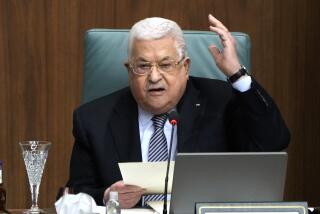Egypt’s new cabinet meets as protests continue
- Share via
Reporting from Cairo — Egypt’s newly appointed cabinet met Monday as the government attempted to reassert stability over the turbulent country with protesters in Cairo’s Tahrir Square continuing to resist the new administration.
The cabinet met without the widely despised former Interior Minister, Habib al-Adly -- replaced by another police general, Mahmud Wagdi -- and some signs of freedom were becoming apparent for the large number of protesters detained over the past two weeks.
Following widespread international outrage, a Google executive was scheduled to be released Monday afternoon, Egyptian television reported. Wael Ghonim, Google’s head of marketing for the Middle East and North Africa, had traveled to Egypt from his home in Dubai and was believed arrested Jan. 27.
Ghonim was arrested after joining the protests in central Cairo, according to Amnesty International investigators who spoke to eyewitnesses.
Ghonim announced on his Twitter feed before his arrest that he had been “brutally beaten up by police people.” Not long before he disappeared, he wrote: “Very worried as it seems that government is planning a war crime tomorrow against people. We are all ready to die.”
The release of prisoners has been a key demand of opposition representatives who met with newly appointed Vice President Omar Suleiman. They also are looking immediately for greater press freedom, a lifting of emergency laws, and restraint in the use of force against anti-government protesters, in addition to comprehensive political reforms.
Government spokesman Magdy Rady said there has been so much instability that “some groups” may be holding detainees without the government’s authorization.
“In the mess we are in, everything is possible,” Rady told the Associated Press, adding that the government is investigating all reports of missing persons. “We are really against these forces now,” he said.
Protest leaders say the security services have been responsible for widespread detentions and beatings, and while the cabinet began the day-to-day business of attempting to restore normalcy to the country, their occupation of Tahrir Square continued.
Large crowds filled the square through much of Sunday night with loud speeches, music and celebrations, though the carnival-like atmosphere turned briefly into panic with the sound of an extended burst of automatic gunfire. It was reportedly shots fired into the air by a soldier as a warning to activists who had moved in to protect a line of razor wire blocking access to the square.
Past midnight, the square settled into quiet, and the numbers by morning were significantly smaller, though many protesters were still sleeping in tents. Protest leaders said larger numbers were expected at the square after returning to their homes for the night.
“No one has tired out,” said Mina Fakhouri, a business student from Mnoufia. “No one is going to be tired before he [President Hosni Mubarak] resigns, even if it takes six months.”
Aya Elkabbany, 25, who has been coming to the square since the first day of protests, said protesters would not vacate before Mubarak’s departure.
“These people that came here won’t leave except as corpses,” said Elkabbany, who teaches in a dental school. “We are still sitting because we are convinced that this country will be fixed.”
More to Read
Sign up for Essential California
The most important California stories and recommendations in your inbox every morning.
You may occasionally receive promotional content from the Los Angeles Times.










